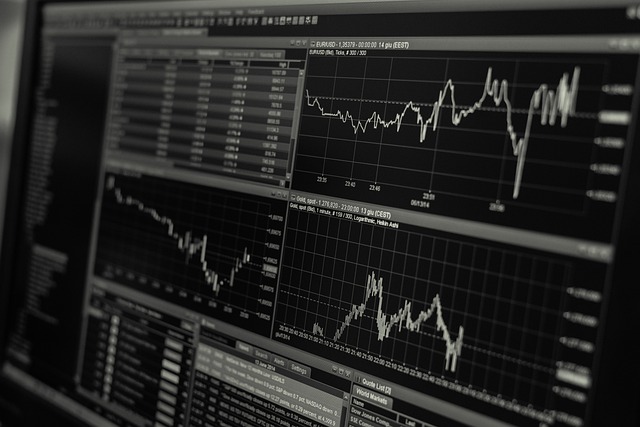Are Pionex Trading Bots Profitable in 2025? An In-Depth Analysis
Author: Jameson Richman Expert
Published On: 2025-07-30
Prepared by Jameson Richman and our team of experts with over a decade of experience in cryptocurrency and digital asset analysis. Learn more about us.
As the cryptocurrency landscape continues to evolve rapidly, traders are increasingly turning to automated solutions like Pionex trading bots to capitalize on market opportunities with minimal manual intervention. In 2025, understanding whether these bots remain a profitable tool requires a comprehensive examination of their operational mechanics, the current market environment, strategic deployment, and associated risks. This detailed analysis aims to provide traders, investors, and enthusiasts with an in-depth perspective grounded in technical insights, market data, and industry trends.

Understanding Pionex Trading Bots: Core Mechanics and Features
Pionex stands out as a pioneer in integrating automated trading bots directly into a cryptocurrency exchange platform, removing the need for external APIs or coding. Its focus on user-friendly design combined with advanced trading algorithms makes it accessible to both novice and experienced traders. The core mechanics involve real-time market data analysis, strategic order placement, and risk management protocols, all customizable via intuitive interface settings.
- Grid Trading Bot: This bot automates buy and sell orders within a predefined price range, profiting from oscillations in sideways markets. It divides the range into multiple grid levels, executing trades at each level to capture small price movements. Its effectiveness depends heavily on market volatility, grid spacing, and the chosen asset's liquidity.
- Spot-Futures Arbitrage Bot: Exploits small price discrepancies between spot and futures markets, which often occur due to liquidity imbalances or temporary market inefficiencies. This strategy requires rapid order execution and high liquidity to capitalize on fleeting arbitrage opportunities, often involving leverage to amplify gains.
- DCA (Dollar Cost Averaging) Bots: Automates periodic investments at fixed intervals, reducing exposure to volatility and avoiding emotional trading decisions. They help in smoothing entry points during volatile periods, making them suitable for long-term accumulation strategies.
- Reverse Grid and Margin Trading Bots: Reverse grid strategies place orders outside the current trading range, aiming to profit from breakout movements, especially in trending markets. Margin bots leverage borrowed funds to amplify gains, but they also significantly increase risk, necessitating disciplined risk management and stop-loss controls.
Each bot employs sophisticated algorithms that process a multitude of data points including real-time price feeds, order book depth, trading volume, and technical indicators like RSI, MACD, Bollinger Bands, and Moving Averages. These parameters are adjustable by users to tailor strategies according to asset volatility, market conditions, and risk appetite. Pionex enhances strategy effectiveness through features like backtesting, real-time analytics, and automated optimization tools, enabling users to refine their tactics continuously.
Market Conditions in 2025 and Their Impact on Bot Profitability
The profitability of automated trading in 2025 is deeply intertwined with macro and micro market factors, which include:
- Volatility Trends: Elevated volatility, driven by macroeconomic uncertainties, geopolitical tensions, and regulatory shifts, creates abundant trading signals but also heightens risk. Ranging markets with moderate oscillations tend to favor grid and arbitrage bots, while trending markets benefit trend-following strategies like margin bots. Data from 2025 indicates persistent high volatility in certain sectors, demanding adaptive strategies and dynamic parameter adjustments.
- Regulatory Environment: Regulatory actions continue to shape market dynamics. Recent laws enhancing KYC/AML compliance, asset bans, or leverage restrictions impact liquidity and arbitrage opportunities. For example, increased restrictions in key jurisdictions have temporarily reduced trading volumes and liquidity, affecting arbitrage and grid strategies. Conversely, clearer regulations can foster market stability, benefiting longer-term trading approaches.
- Technological Advancements: Blockchain scalability improvements, faster data feeds, and AI-driven analytics have enhanced bot responsiveness. Machine learning models now predict short-term price movements with higher accuracy, allowing for more adaptive, real-time strategy adjustments, thus improving profitability potential.
- Market Maturity and Adoption: The increasing participation of institutional investors and mainstream adoption tend to stabilize markets, reducing extreme volatility and arbitrage opportunities but fostering more predictable, steady gains. This environment favors strategies focused on incremental profits, long-term accumulation, and diversification.
For instance, during sustained bullish phases driven by technological breakthroughs or macroeconomic tailwinds, trend-following bots may generate higher returns. Conversely, sideways markets with frequent oscillations favor grid and arbitrage strategies. Incorporating flexible, multi-strategy portfolios and constantly fine-tuning parameters based on market signals are essential for maintaining profitability in such dynamic conditions.
Strategies for Enhancing Profitability with Pionex in 2025
To maximize returns from Pionex trading bots, traders should adopt a multi-faceted approach centered on continuous analysis, adaptive strategy deployment, and prudent risk management:
- Market Condition Assessment: Employ technical analysis tools—like moving averages, RSI, Bollinger Bands, and volume analysis—to identify the prevailing market phase. Using sentiment analysis and macroeconomic indicators can further inform strategic shifts, such as switching from grid to trend-following tactics during trending markets.
- Optimal Parameter Configuration: Regularly recalibrate bot settings—grid size, investment per grid, stop-loss, take-profit—based on real-time volatility metrics. During high volatility, expanding grid ranges and setting wider stop-loss buffers prevents premature exits, while during stable periods, tighter parameters optimize gains.
- Diversification: Spread investments across multiple assets—BTC, ETH, DeFi tokens, and emerging altcoins—and across different exchange platforms. Cross-platform arbitrage, facilitated via integrations with exchanges like MEXC and Bitget, can further diversify risk and capture arbitrage opportunities.
- Active Monitoring and Adjustment: Utilize dashboards, real-time alerts, and automated triggers to track bot performance and market shifts. Promptly pause or adjust strategies during sudden market shocks or news events. Implementing dynamic stop-losses and take-profit levels safeguards against large drawdowns.
- Leverage AI and Data Analytics: Integrate AI-powered predictive models and sentiment analysis tools that leverage news feeds and social media trends to anticipate short-term market movements. These insights enable proactive adjustments, increasing the likelihood of profitable trades while maintaining controlled risk exposure.
Successful traders combine these tactics with disciplined risk controls—such as conservative stop-losses, position sizing, and portfolio diversification—and regular performance reviews to adapt to evolving market conditions. The integration of manual oversight with automated strategies ensures resilience and sustained profitability.

Risks and Challenges in 2025
While Pionex bots offer significant profit potential, several risks threaten their profitability in 2025:
- Market Crashes and Sudden Volatility: Rapid downturns—like flash crashes or geopolitical shocks—can trigger catastrophic losses or premature stop-outs. For example, recent geopolitical tensions have caused swift market declines, testing bot resilience. Incorporating buffer zones, dynamic stop-losses, and circuit breakers is vital for risk mitigation.
- Technical Failures: System outages, API disconnections, or software bugs can interrupt trading activities. Maintaining robust infrastructure, implementing redundant systems, and continuous monitoring are crucial. Manual intervention protocols should be in place to prevent losses during technical failures.
- Regulatory Restrictions: Evolving laws may restrict certain trading activities, limit leverage, or ban specific assets. Staying compliant requires continuous updates to trading strategies and platform use policies, as well as proactive engagement with regulatory developments.
- Over-Optimization and Overfitting: Excessive tuning based on historical data can lead to strategies that perform poorly under unforeseen market conditions. Emphasizing adaptive algorithms, machine learning models, and avoiding static configurations can reduce overfitting risks.
To mitigate these risks, traders should employ diversified portfolios, implement strict risk controls, and maintain manual oversight to intervene during anomalies or extreme events. Regularly reviewing strategy performance and adapting to new market realities are essential for long-term success.
Future Outlook: Will Pionex Trading Bots Remain Profitable?
The outlook for Pionex trading bots in 2025 appears promising, driven by ongoing advancements in AI, machine learning, and blockchain technology. Smarter algorithms that adapt to market conditions, combined with the proliferation of DeFi protocols and cross-platform arbitrage, expand profit opportunities. Institutional adoption and increased market maturity tend to stabilize markets, potentially reducing extreme oscillations but fostering more predictable returns.
Nevertheless, the competitive landscape is intensifying, requiring traders to continuously innovate and optimize strategies. Staying ahead in this environment involves leveraging new data sources, AI enhancements, and maintaining rigorous risk management practices. The ability to swiftly adapt to regulatory changes and technological shifts will be crucial for maintaining profitability.
Conclusion: The Profitability Verdict for 2025
In conclusion, Pionex trading bots have the potential to remain highly profitable in 2025 when employed with a strategic, informed approach. Their effectiveness is heavily influenced by market conditions, configuration precision, and prudent risk controls. While automation offers speed, efficiency, and scalable opportunities, it is not a guaranteed path to profits. Active management, continuous research, and flexibility are essential to succeed in this rapidly evolving environment.
For traders aiming to maximize gains, combining Pionex with other platforms such as Binance, MEXC, Bitget, and Bybit can diversify risk, enhance arbitrage opportunities, and improve overall portfolio resilience. Maintaining vigilance, continuous learning, and strategic flexibility will be key to thriving in the dynamic crypto trading ecosystem of 2025.